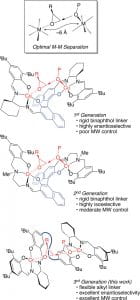Two major goals of catalysis are the efficient preparation of enantiopure small molecules and stereoregular polymers. Our group recently reported a cobalt-based bimetallic catalyst for the enantioselective polymerization of epoxides that achieves both objectives at the same time. Starting from racemic terminal epoxides the catalyst produces isotactic polyethers and enantiopure epoxides in high yields and short reaction times. The polyethers formed are highly isotactic (> 99% mm), and the selectivity factors (s-factor, kfast/kslow) most often exceed 50, which makes this system useful for the synthesis of highly enantioenriched epoxides.
These new isotactic polyethers have numerous potential applications. For example, they could help improve everyday foams, sealants, surfactants, elastomers, and biomedical components, which currently are based on atactic polyethers. Futhermore, enantiopure epoxides are important building blocks for pharmaceuticals and other stereoregular polymers.
- Morris, L. S.; Childers, I. M.; Coates, G. W. Angew. Chem., Int. Ed. 2018, 57, 5731–5734. doi: 10.1002/anie.201801380
-
Lipinski, B. M.; Morris, L. S.; Silberstein, M. N.; Coates, G. W. J. Am. Chem. Soc. 2020, 142, 6800−6806. doi: 10.1021/jacs.0c01768
-
Lipinski, B. M.; Walker, K. L.; Clayman, N. E.; Morris, L. S.; Jugovic, T. M. E.; Roessler, A. G.; Getzler, Y. D. Y. L.; MacMillan, S.N.; Zare, R. N.; Zimmerman, P. M.; Waymouth, R. M.; Coates, G. W. ACS Catal. 2020, 10, 8960−8967. doi: 10.1021/acscatal.0c02135



